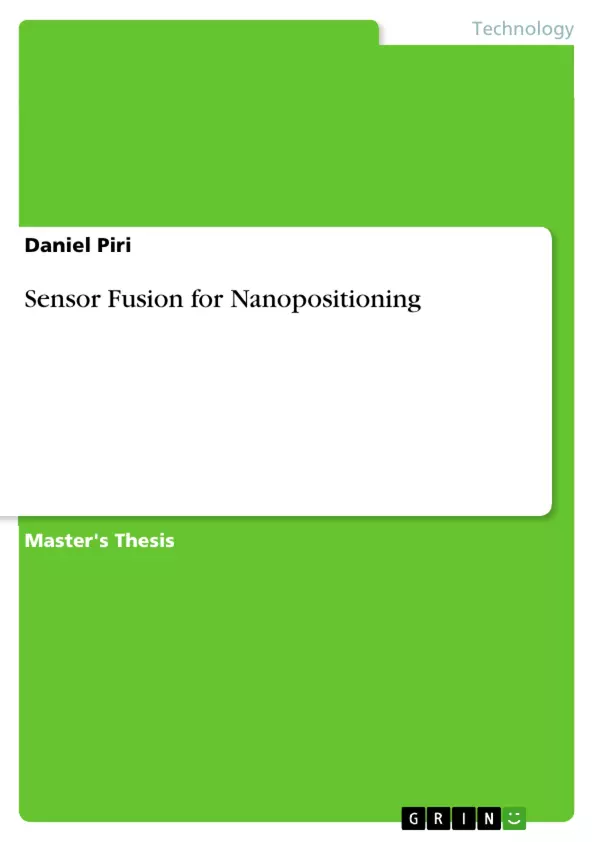Sensors can be used to measure the position of an object. In the present thesis the effects which limit the usage of sensors in high dynamic positioning applications on a nanometer level are discussed. Various sensor principles and their properties are investigated and compared. Sensors based on the measurement of i.a. magnetic fields, illumination, or even strain are characterized, as well as their range, bandwidth, resolution, linearity and disturbance rejection is determined.
It will be shown that the simultaneous use of multiple sensors and the specific combination of sensors’ data (fusion) enables a higher performance primarily in terms of resolution and dynamics. Several techniques for the fusion are discussed under consideration of various aspects, however the ultimate aim of sensor fusion is similar.
The methods of feedforward control, complementary filtering, Kalman filtering and optimal filtering (robust control) are developed and verified on practical problems in position sensor systems. To treat various challenges in sensor filtering and sensor fusion a methodological approach, containing separable steps of
• problem formulation with well-defined prerequisits and simplifications,
• theory discussion with approach to find a solution,
• analytical proof or reasoning by statistical values out of numerical simulations,
• experiment design, and
• verification on a real time platform are realized.
Inhaltsverzeichnis (Table of Contents)
- Acknowledgement
- Abstract
- Zusammenfassung
- 1. Introduction
- 1.1. Sensor Principles
- 1.2. Sensor Fusion
- 2. Sensor Characterization
- 2.1. Position Measurement
- 2.1.1. Magnetic Fields
- 2.1.2. Illumination
- 2.1.3. Strain
- 2.2. Sensor Noise
- 3. Sensor Fusion Techniques
- 3.1. Feedforward Control
- 3.2. Complementary Filtering
- 3.3. Kalman Filtering
- 3.4. Optimal Filtering
- 4. Applications
- 4.1. Nanopositioning Systems
- 4.2. Atomic Force Microscopy
- 5. Conclusion
Zielsetzung und Themenschwerpunkte (Objectives and Key Themes)
This master thesis explores the limitations of sensors in high-dynamic nanopositioning applications and proposes solutions through sensor fusion techniques. The work aims to demonstrate the advantages of combining multiple sensor data for achieving higher resolution and bandwidth in position control. Key themes explored in the thesis include:- Sensor principles and their limitations in nanopositioning.
- Sensor noise analysis and its impact on performance.
- Methods for sensor data fusion, including feedforward control, complementary filtering, Kalman filtering, and optimal filtering.
- Practical applications of sensor fusion in nanopositioning systems and atomic force microscopy.
- A methodological approach for problem formulation, theoretical analysis, and verification on real-time platforms.
Zusammenfassung der Kapitel (Chapter Summaries)
- Chapter 1: Introduction This chapter introduces the concept of sensor fusion and its relevance in high-dynamic nanopositioning applications. It outlines the limitations of individual sensors and highlights the benefits of combining data from multiple sensors.
- Chapter 2: Sensor Characterization This chapter focuses on the characterization of different sensor principles used in nanopositioning, including magnetic fields, illumination, and strain. It examines the properties of each sensor type, such as range, bandwidth, resolution, linearity, and disturbance rejection.
- Chapter 3: Sensor Fusion Techniques This chapter presents various sensor fusion techniques, including feedforward control, complementary filtering, Kalman filtering, and optimal filtering. It discusses the advantages and limitations of each technique and explores their application in practical problems.
- Chapter 4: Applications This chapter explores the practical applications of sensor fusion in nanopositioning systems and atomic force microscopy. It demonstrates how sensor fusion can improve performance and address real-world challenges in these fields.
Schlüsselwörter (Keywords)
The core themes and concepts explored in this work include sensor fusion, nanopositioning, high dynamics, high resolution, sensor noise, Kalman filter, H2-optimal filter, and H∞-optimal filter. This thesis examines the application of these concepts in achieving high-precision position control for nano-scale applications, focusing on the advantages and limitations of various sensor fusion techniques.- Quote paper
- Daniel Piri (Author), 2014, Sensor Fusion for Nanopositioning, Munich, GRIN Verlag, https://www.grin.com/document/286249



